Regional Rapid Transit System (RRTS):Features,Fares,Stations and More
Updated on : 04 January,2025
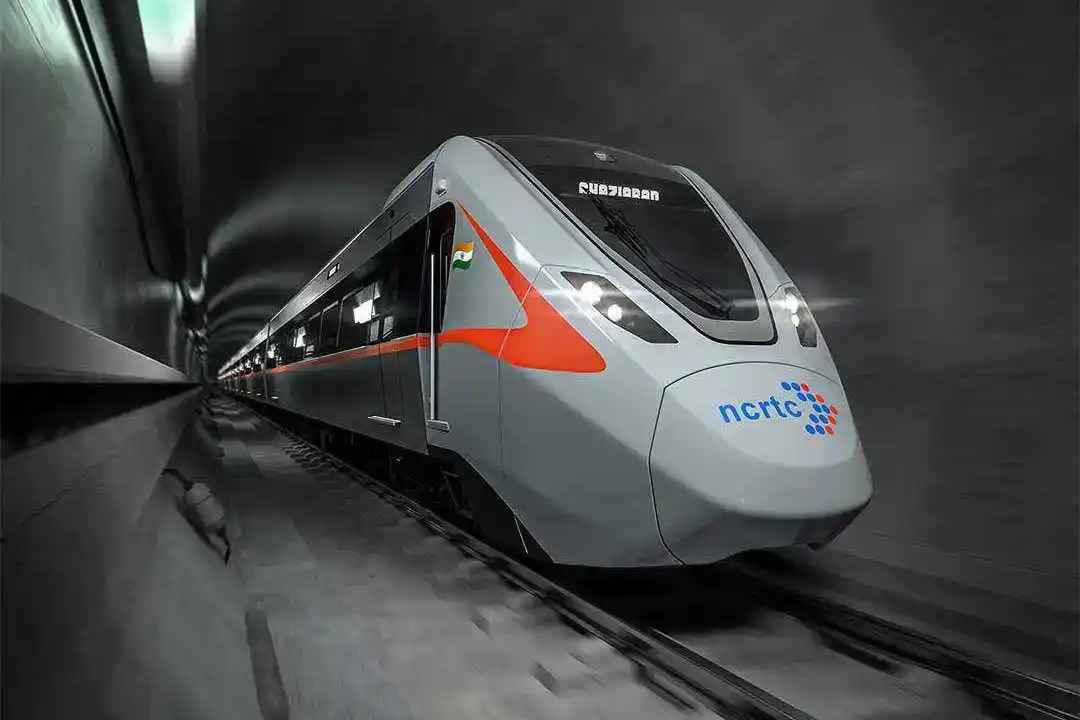
Image Source: ncrtc
The Regional Rapid Transit System (RRTS) is a transformative transportation initiative aimed at enhancing connectivity within the National Capital Region (NCR) of India. Designed to facilitate faster, more efficient travel between urban centers, the RRTS is set to revolutionize the way people commute across the NCR.
1. What is RRTS?
The Namo Bharat RRTS is a semi-high-speed rail network designed to connect key towns and cities across the National Capital Region (NCR), including Delhi, Ghaziabad, and Meerut. With a maximum design speed of 180 km/h and an operational speed of around 160 km/h, the RRTS aims to deliver high-frequency commuter services. It is poised to significantly reduce travel times, offering a faster and more efficient alternative to current transportation options in the region.
Key Features:
- Dedicated Tracks: Unlike traditional railways and metro systems, RRTS operates on dedicated tracks designed specifically for regional travel.
- High Capacity: The system can accommodate a large number of passengers, making it ideal for densely populated regions.
- Comfortable Travel: Trains are designed to provide a comfortable commuting experience with amenities such as air conditioning and luggage carriers.
Popular Blogs
Historical Background
The concept of RRTS was first proposed in a study commissioned by Indian Railways in 1998-99. The idea gained traction over the years, leading to the establishment of the National Capital Region Transport Corporation (NCRTC) in 2013 to oversee its implementation. The project was included in the Integrated Transport Plan for NCR 2032, which identified eight potential corridors for development.
Project Overview
The first operational corridor of the RRTS is the Delhi-Ghaziabad-Meerut corridor, spanning approximately 82.15 km with 16 stations. The initial phase includes a priority section of 17 km from Sahibabad to Duhai, which was inaugurated on October 20, 2023.
Key Statistics:
- Total Length: 82.15 km
- Number of Stations: 22
- Travel Time: Reduced from over three hours to under one hour between Delhi and Meerut.
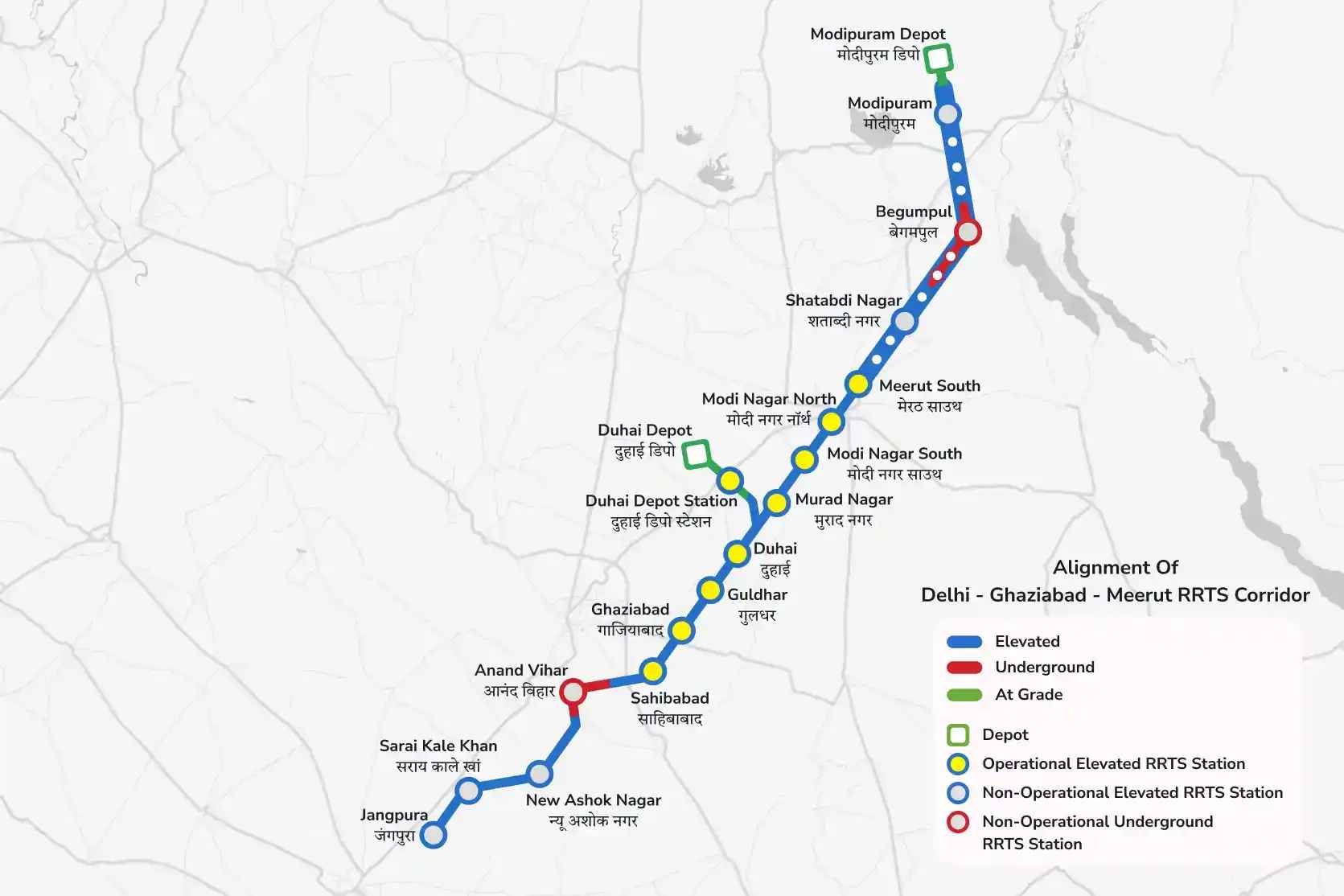
Image Source: ncrtc
Objectives of RRTS:
- Decongesting Cities:
- By providing an alternative to personal vehicles and overcrowded public transport, RRTS alleviates traffic jams in metropolitan areas, reducing travel time and improving urban livability.
- Improving Regional Accessibility:
- RRTS links urban centers with smaller towns and rural areas, ensuring balanced regional development and better access to resources, employment, and education.
- Encouraging Public Transit:
- With efficient services, RRTS aims to shift commuter preference from private vehicles to public transport, thereby reducing dependency on fossil fuels.
- Promoting Economic Development:
- By improving connectivity, RRTS helps foster regional economic integration, enhancing trade, commerce, and investments.
- Reducing Environmental Impact:
- The adoption of electric trains and promotion of green mobility options significantly contribute to lowering air pollution and carbon emissions.
Inauguration Ceremony
The inauguration of the Anand Vihar to Meerut section of the Regional Rapid Transit System (RRTS) marks a major milestone in improving connectivity between Delhi and the National Capital Region (NCR). The event, set for January 5, 2025, will feature Prime Minister Narendra Modi flagging off a train from Sahibabad station in Ghaziabad to New Ashok Nagar in Delhi, with a stop at the newly constructed Anand Vihar station.
Key Details of the Inauguration
- Date: January 5, 2025
- Inaugurating Official: Prime Minister Narendra Modi
- Route: Sahibabad to New Ashok Nagar via Anand Vihar
- Distance: 13 kilometers
Operational Updates
- Operational Length Post-Inauguration:
The RRTS operational length will increase to 55 kilometers. - Future Plans:
The corridor is expected to extend to 82 kilometers by June 2025.
Ghaziabad Traffic Advisory: Route Restrictions
- No Entry for Commercial Vehicles
- Movement of all heavy, medium, and light commercial vehicles is prohibited between Mohan Nagar and UP Gate.
- Commercial vehicles are not allowed from Karangate Roundabout towards the Hindon Air Force Station entry gate.
- Similar restrictions apply on the route from Rotary Roundabout via Nagdwar to the Hindon Air Force Station entry gate.
- Full Traffic Restrictions During Program
- All vehicle movement is restricted between the Hindon Air Force Station entry gate and Vaishali Metro Station (via Mohan Nagar) during the event.
Public Notice:
Residents are advised to avoid these routes until the program concludes on January 5, 2025, and to use alternate routes to minimize inconvenience.
Stations of the Delhi-Ghaziabad-Meerut RRTS
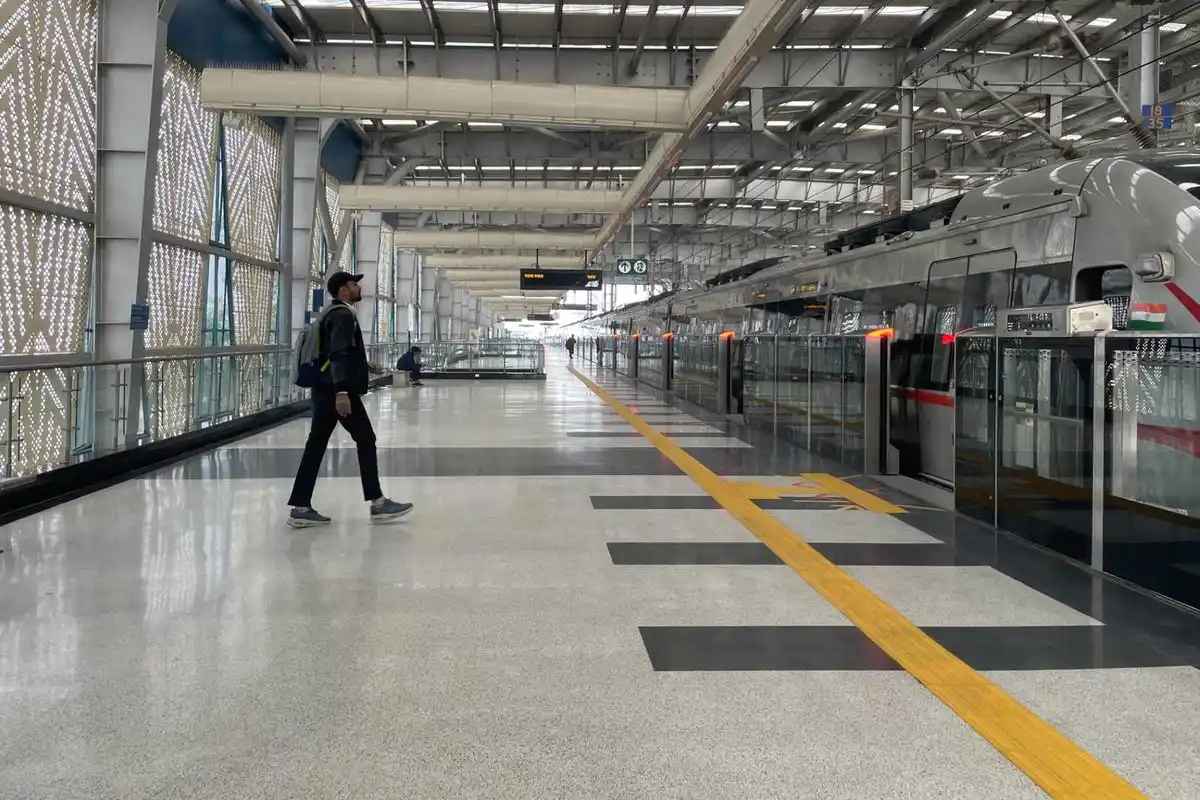
Image Source: thgim.com
The Delhi-Ghaziabad-Meerut Regional Rapid Transit System (RRTS) is a transformative infrastructure project designed to enhance connectivity within the National Capital Region (NCR) of India. Spanning 82.15 kilometers, the corridor includes 22 stations, featuring a mix of elevated and underground sections.
| Station Name | Type | Features |
|---|---|---|
| Nizamuddin / Sarai Kale Khan | Elevated | Integrates with the Delhi Metro, providing seamless connectivity to other transit modes. |
| New Ashok Nagar | Elevated | Close proximity to the New Ashok Nagar Metro station, enhancing accessibility for commuters. |
| Anand Vihar | Underground | Major transit hub connecting with Delhi Metro and ISBTs; designed for high foot traffic with multiple entry and exit points. |
| Sahibabad | Elevated | Provides access to residential areas and connects with local bus services. |
| Ghaziabad | Elevated | Acts as a central point for commuters traveling to and from Ghaziabad city. |
| Guldhar | Elevated | Designed for universal accessibility with two entry and exit gates; serves nearby residential colonies. |
| Duhai (EPE) | Elevated | Proximity to educational institutions; includes a depot for operational control. |
| Murad Nagar | Elevated | Seamless integration with the Murad Nagar bus station; two entry and exit gates for accessibility. |
| Modi Nagar South | Elevated | Currently under construction, designed to serve local residential areas. |
| Modi Nagar North | Elevated | Planned to enhance connectivity within the Modi Nagar region. |
| Meerut South | Elevated | Key station serving as a gateway to Meerut city. |
| Partapur | Elevated | Connects with local transportation networks; designed for easy access. |
| Rithani | Elevated | Serves surrounding residential areas; facilitates smooth commuter flow. |
| Shatabdi Nagar | Elevated | Enhances accessibility for residents in nearby neighborhoods. |
| Brahmapuri | Elevated | Provides easy access to local amenities and services. |
| Meerut Central | Elevated | Acts as a crucial transit point within Meerut, integrating various transport modes. |
| Bhaisali | Elevated | Designed to cater to local commuter needs with accessible facilities. |
| Begum Pul | Elevated | Enhances connectivity between different parts of Meerut city. |
| MES Colony | Elevated | Serves military establishments and nearby residential areas. |
| Daurli | Elevated | Facilitates access for residents in the Daurli locality. |
| Meerut North | Elevated | Provides additional connectivity options within Meerut city. |
| Modipuram | Elevated | Planned to serve the Modipuram area, enhancing regional connectivity. |
How RRTS Differs from Other Transport Systems
| Aspect | RRTS | Metro | Traditional Railways |
|---|---|---|---|
| Purpose | Long-distance regional travel | Local urban connectivity | Intercity and long-distance travel |
| Speed | Up to 180 km/h | Up to 100 km/h | Varies widely |
| Frequency | Every 15 minutes (up to every 5) | Varies by line | Less frequent |
| Comfort Features | Premium seating options | Basic seating | Varies by service |
| Pathway | Dedicated tracks | Mixed-use tracks | Shared tracks with freight |
Train Specifications
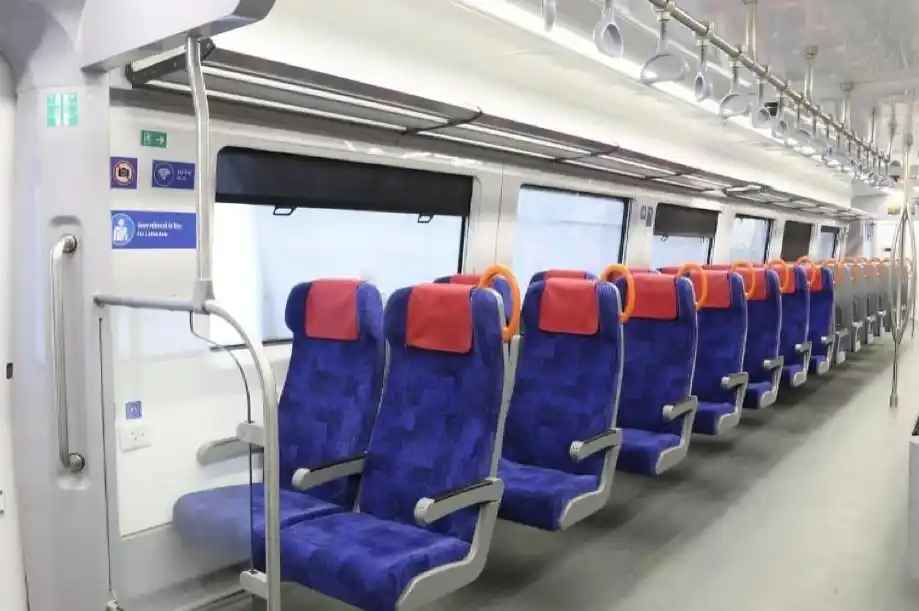
Image Source: news18.com
-
Train Composition: Each RRTS train consists of six coaches, accommodating up to 1,700 passengers. The configuration includes five standard coaches and one premium coach.
-
Seating Arrangement: The standard coaches feature a 2x2 transverse seating arrangement, optimizing passenger comfort and space. The premium coach offers reclining seats, coat hooks, magazine holders, and footrests for added luxury.
-
Safety Systems: Trains are equipped with fire and smoke detectors, fire extinguishers, and a comprehensive CCTV surveillance system to enhance passenger safety.
-
Advanced HVAC System: The trains include a state-of-the-art Heating, Ventilation, and Air Conditioning (HVAC) system that maintains a comfortable environment regardless of external weather conditions.
-
High-Performance Propulsion: The trains feature a lightweight and compact propulsion system designed for high reliability and performance, capable of achieving operational speeds of up to 160 km/h.
-
Infotainment Systems: Each train is equipped with a public announcement system, infotainment displays, and dynamic route map displays to keep passengers informed during their journey.
Ticket Prices
The Delhi-Ghaziabad-Meerut Regional Rapid Transit System (RRTS) offers a structured fare system that caters to both standard and premium class passengers, with fares based on the distance traveled. Below are the details regarding ticket prices.
Fare Structure
Standard Class Tickets
- Minimum Fare: ₹20
- Maximum Fare: ₹50
This fare applies to shorter journeys, such as those between adjacent stations like Sahibabad and Ghaziabad.
Premium Class Tickets
- Minimum Fare: ₹40
- Maximum Fare: ₹100
Premium fares are applicable for longer distances, providing additional comfort and amenities.
Specific Ticket Prices Between Stations
| Route | Standard Class Fare | Premium Class Fare |
|---|---|---|
| Sahibabad to Ghaziabad | ₹30 | ₹60 |
| Sahibabad to Guldhar | ₹20 | ₹40 |
| Sahibabad to Duhai | ₹40 | ₹80 |
| Sahibabad to Duhai Depot | ₹50 | ₹100 |
| Ghaziabad to Duhai Depot | ₹30 | ₹100 |
Additional Information
- Children under 90 cm in height can travel for free.
- Luggage Allowance: Passengers are allowed to carry luggage up to 25 kg, with size limits of 80 cm in length, 50 cm in width, and 30 cm in height.
Ticket Booking Options
- Mobile App: Tickets can be booked via the RAPIDX Connect app.
You can download the app from the following stores:
- Ticket Vending Machines (TVMs): Located at various stations, these machines accept cash and card payments.
- Station Counters: Tickets can also be purchased directly from ticket counters at stations.
Parking Areas of RRTS
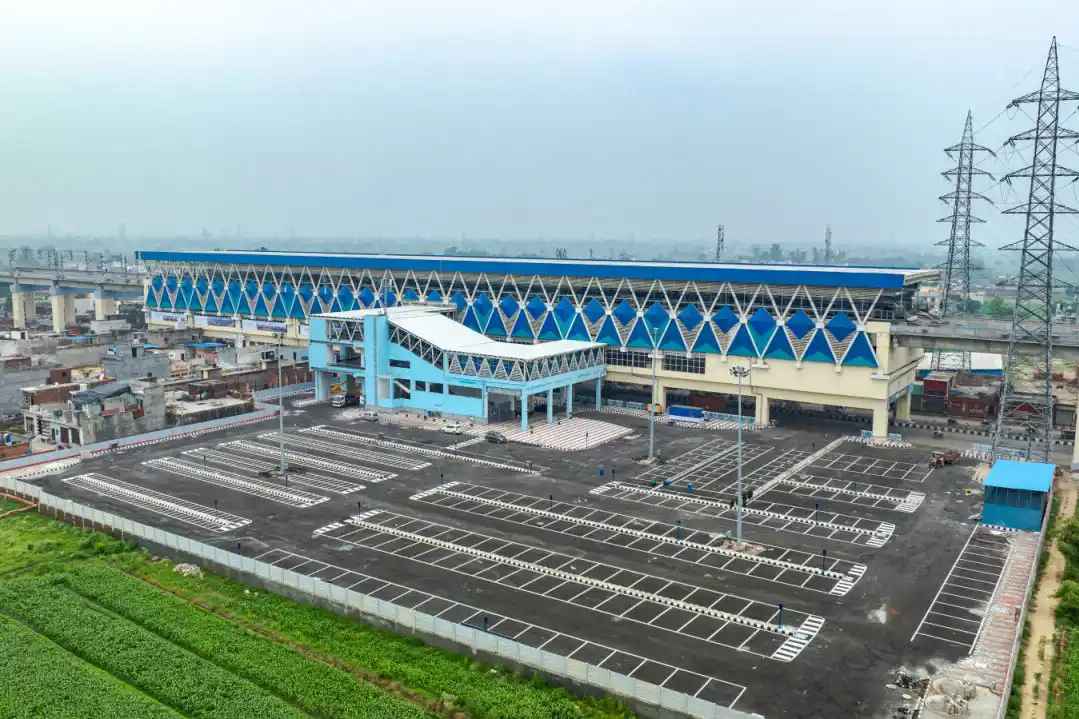
Image Source: metrorailnews.in
The Delhi-Ghaziabad-Meerut RRTS corridor features extensive parking facilities across its 25 stations, developed by the National Capital Region Transport Corporation (NCRTC) to accommodate over 8,000 vehicles, including cars, two-wheelers, and bicycles.
Key Parking Locations
- Meerut South Station
- Capacity: Approximately 300 cars and 900 two-wheelers.
- This station has the largest parking area along the corridor.
- Sarai Kale Khan Station
- Capacity: Around 275 cars and 900 two-wheelers.
- This facility is the second largest in terms of parking space.
- Other Stations
- All stations along the corridor provide designated parking areas for easy commuter access.
Parking Fee Structure
To encourage the use of public transport and ensure efficient parking management, the NCRTC has implemented the following fee structure:
Free Parking: First 10 minutes for pick-up and drop-off.
- Up to 6 Hours:
- Bicycles: ₹5
- Two-Wheelers: ₹10
- Cars: ₹25
- 6 to 12 Hours:
- Bicycles: ₹5
- Two-Wheelers: ₹25
- Cars: ₹50
- Beyond 12 Hours:
- Bicycles: ₹10
- Two-Wheelers: ₹30
- Cars: ₹100
- Night Parking (Non-Operational Hours):
- Bicycles: ₹20
- Two-Wheelers: ₹60
- Cars: ₹200
Additional Amenities at RRTS Parking Areas
The RRTS parking facilities are designed to align with modern transportation trends and provide a convenient and sustainable experience for commuters. Key amenities include:
Electric Vehicle Charging Stations
To support the increasing adoption of electric vehicles (EVs), charging stations are being installed at various parking locations along the corridor.
Battery Swapping Stations
Dedicated battery swapping facilities are available to cater to both commuters and last-mile service providers, promoting sustainable and efficient transportation options.
Real-Time Updates
The RRTS Connect app enhances the commuter experience by providing:
- Live train schedules
- Real-time parking availability updates
These features ensure a seamless and informed journey for all passengers.
Construction Techniques and Technologies
The construction of the RRTS has been divided into several phases:
-
Phase 1: This includes the priority corridor from Sahibabad to Duhai Depot, which was inaugurated on October 20, 2023. This section spans approximately 17 kilometers and features four elevated stations.
-
Phase 2: This phase extends from Duhai Depot to Meerut South and is completed in August 2024.
-
Phase 3: Connecting Sarai Kale Khan to Sahibabad, this phase is targeted for completion by December 2024.
-
Phase 4: Covering Meerut South to Modipuram Depot, this phase is anticipated to begin operations by June 2025.
The RRTS employs advanced construction techniques and technologies to ensure efficiency and safety:
- Elevated Viaducts: A significant portion of the corridor consists of elevated tracks. Approximately 68 kilometers of the route will be elevated, allowing for minimal disruption to existing urban infrastructure.
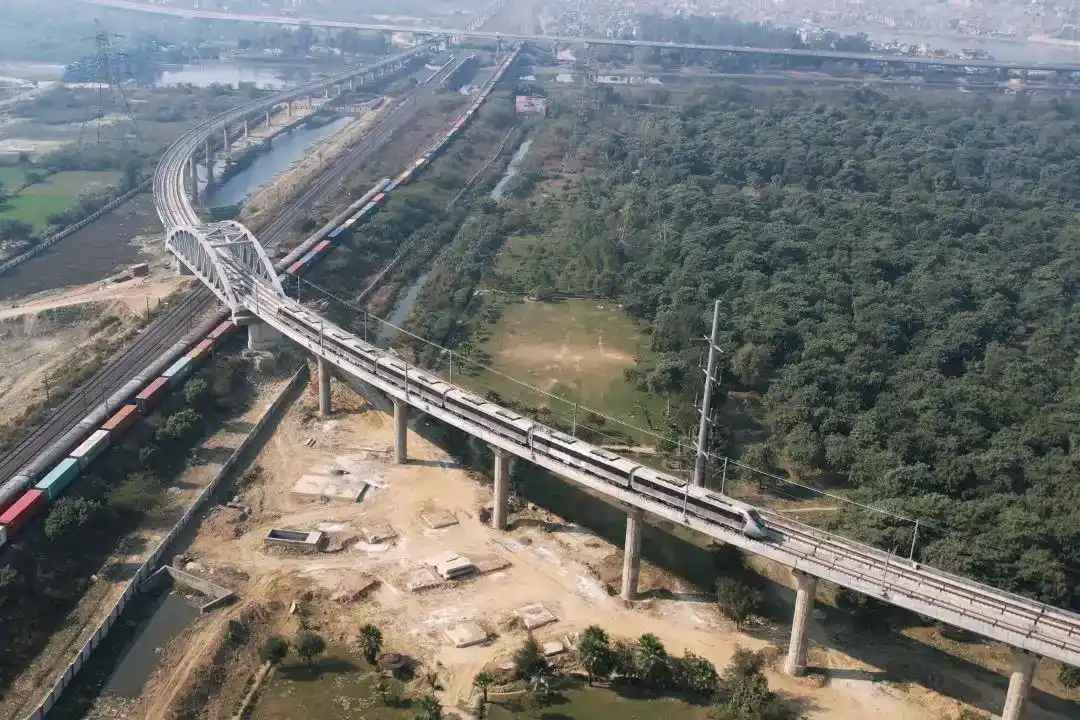
Image Source: team-bhp.com
- Tunnel Boring Machines (TBMs): The project utilizes a total of seven TBMs, with four operated by STEC and three by Afcons Infrastructure. These machines are crucial for constructing the underground sections of the line, which span around 12 kilometers.
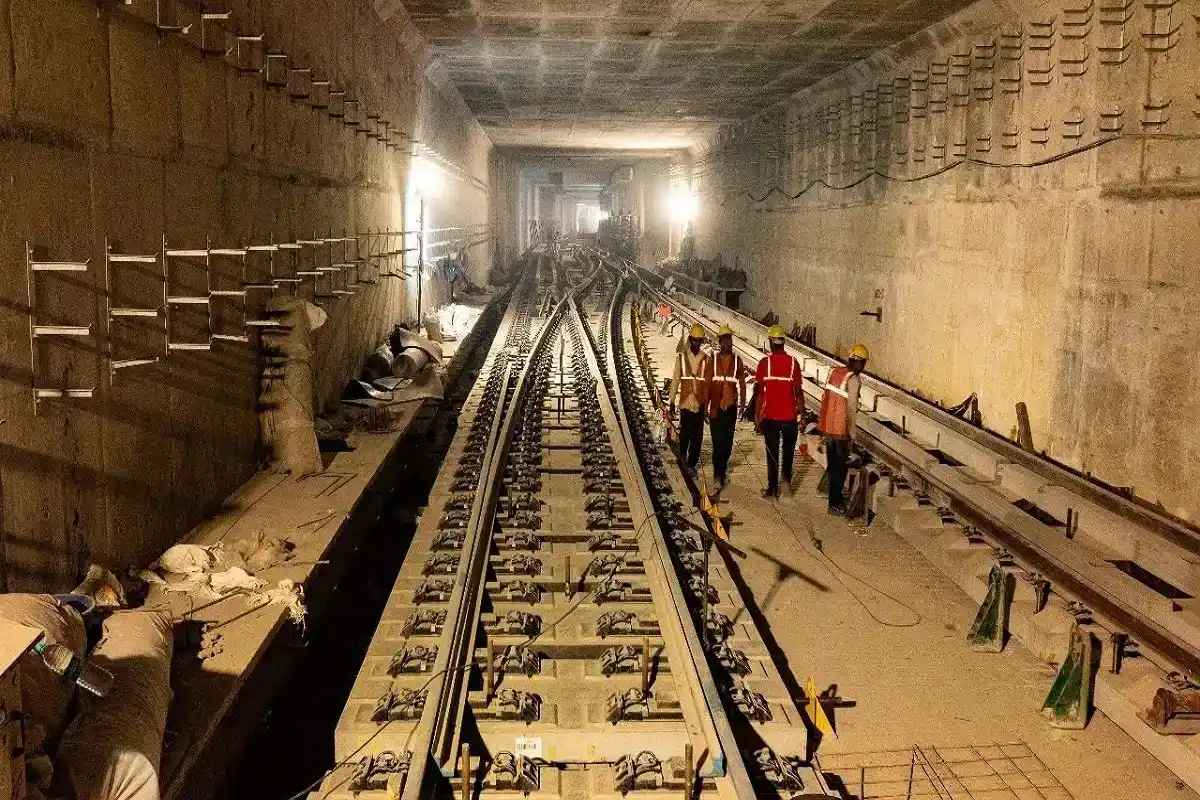
Image Source: informalnewz.com
- Pre-Engineered Steel Structures: The construction includes pre-engineered steel roof structures for various stations, enhancing durability and reducing construction time.
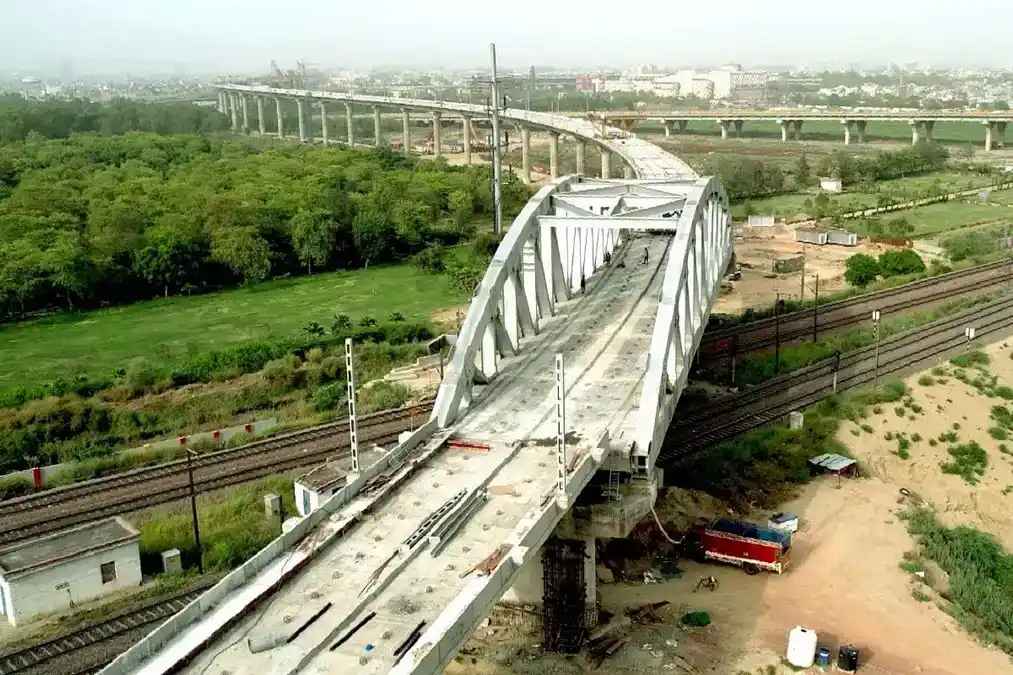
Image Source: swarajyamag.com
Economic and Social Benefits
The RRTS offers significant long-term benefits that go beyond transportation.
- Economic Growth
-
Boost to Regional Economies: Enhanced connectivity promotes industrial growth, trade, and tourism in smaller towns and cities.
-
Real Estate Development: Improved transport infrastructure leads to increased property values and new commercial opportunities.
- Job Creation
- The construction phase has already generated thousands of jobs in engineering, manufacturing, and construction sectors. Post-completion, the operation and maintenance of the RRTS network will provide employment opportunities for technicians, operators, and support staff.
- Improved Quality of Life
- Reduced travel times allow commuters to spend more time with family and engage in leisure activities. Affordable pricing ensures equitable access, improving mobility for economically weaker sections.
- Environmental Impact
- By reducing reliance on cars and buses, RRTS significantly cuts down on greenhouse gas emissions. The green corridor design, with extensive tree planting and noise barriers, minimizes ecological disruption.
- Urban Transformation
- RRTS encourages the development of satellite towns, reducing population pressure on metropolitan cities. Transit-oriented development (TOD) ensures well-planned urban growth along corridors.
Future Corridors
The National Capital Region Planning Board (NCRPB) has decided to implement RRTS in the following three corridors on priority:
- Delhi-Panipat
- Delhi-Alwar
- Delhi-Sonipat
The eight identified RRTS corridors are:
- Delhi – Gurgaon – Rewari – Alwar [DGRA - Project Corridor]
- Delhi – Ghaziabad – Meerut
- Delhi – Sonipat – Panipat
- Delhi – Faridabad – Ballabhgarh – Palwal
- Delhi – Bahadurgarh – Rohtak
- Delhi – Shahadra – Baraut
- Ghaziabad – Khurja
- Ghaziabad – Hapur
Challenges in RRTS Implementation
Despite its many advantages, the RRTS project faces several hurdles:
- Land Acquisition
- Securing land for stations and corridors involves complex negotiations with landowners, often leading to delays and escalated costs.
- Resistance from local communities sometimes creates additional challenges.
- High Capital Investment
- With an estimated cost of over ₹1 lakh crore for all planned corridors, mobilizing funds is a significant challenge. Dependence on external loans from agencies like the Asian Development Bank (ADB) increases financial risk.
- Coordination Among Stakeholders
- The RRTS spans multiple states and administrative zones, requiring seamless collaboration among central and state governments, urban local bodies, and private players.
- Public Adoption
- Changing commuter habits, especially among private vehicle users, requires extensive awareness campaigns and reliable services.
- Technological Risks
- Maintaining advanced signaling and rolling stock technology demands skilled personnel and continuous upgradation.
Conclusion
The Regional Rapid Transit System represents a significant advancement in India’s transportation infrastructure. By providing high-speed connectivity across key urban centers in the NCR, it promises not only to enhance commuter convenience but also to drive economic growth and promote sustainable urban development.
As India continues to grow rapidly, projects like the RRTS are essential for ensuring that transportation systems keep pace with population growth and urbanization trends. With its innovative design and focus on efficiency, comfort, and environmental sustainability, the RRTS is set to become a model for future transit projects throughout India and beyond.
















